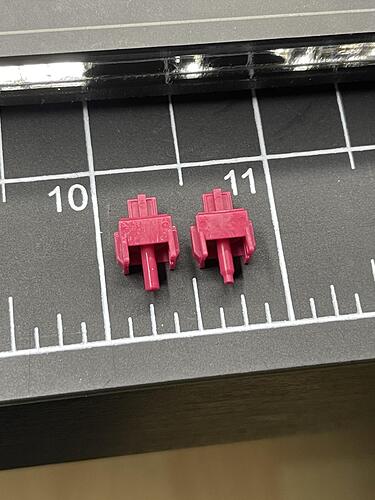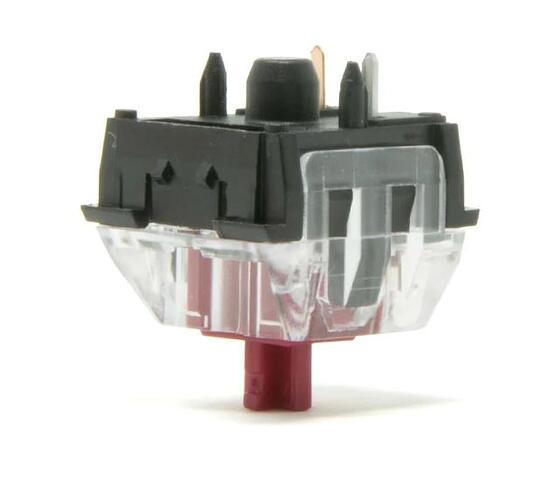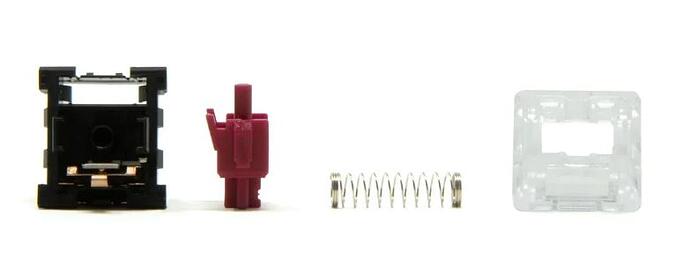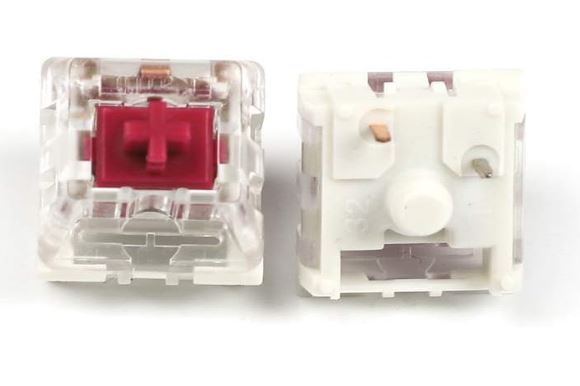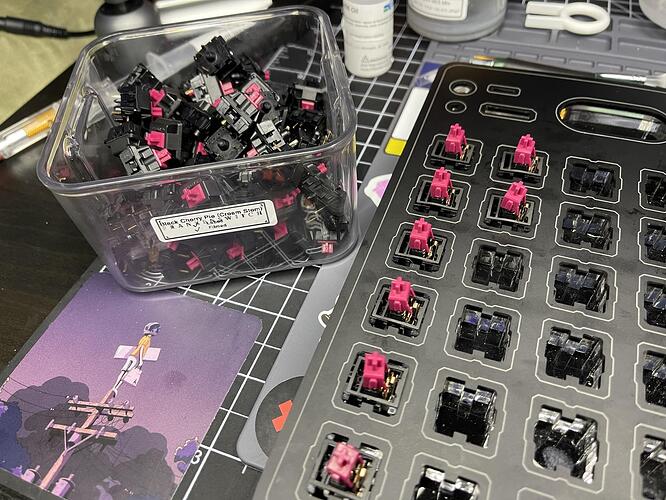Oh heck I fell down an esoteric plastic post writing rabbithole again
Yes, notably UHMWPE and its derivatives, even more-so than with POM. Sort of.
The stick is stronger, but once you’re moving it’s more soapy slick, unless you’re at an extreme angle and/or going really slow. A good example of this is the Tecsee Jadeite, used to be called Diamond. It almost feels like a light tactile because there’s that “stick” at the beginning, but then that soapy glide to a soft-ish bottom-out.
More plastics / blends, re: slip-stick
P3 is slick and contains at least a little bit of umwipe, but it’s pretty firm compared to the pure stuff. It does slip-stick a little with a pure UHMWPE top-housing, so probably will with other blends containing it.
LY seems pretty firm, maybe closer to POM in hardness, but I’ve only tried the one LY-based switch so far in Nebulas and they have Nylon housings. I swapped a Tecsee umwipe housing onto one of those, which kind of almost fits - but it’s clear the LY plastic does indeed slip-stick with UHMWPE.
I even wrote directly to Prevail to ask about LY, including a few plastic-property questions like where it might sit on the scale of amorphous to crystalline. I heard back from a staffer who seemed to dig that someone was asking, but not from anyone that could give me any info.
Ink stuff sure does it. North Pole stems are Ink material, and putting those in Ink housings is slip-stick city. Took me all of two seconds to figure out why Gateron doesn’t sell full-Ink switches.
In poking around it seems UPE might just be a shortening of UHMWPE - I don’t think I’ve specifically used any switches with “UPE” in the marketing - or if I did I’ve forgotten about it. I’d assumed it implied a more firm blend of umwipe but who knows.
Strange and not strange; I fear mystery and curiosity about this or that blend is an effective driver of sales, at least in the short term.
More waxing about that
It’s also quite possible they’re just trying stuff and seeing if people like it, and letting them figure out how to talk about it. It’s also not super easy to articulate the esoteric properties of plastics in the context of haptics and sound across language barriers.
I’m not saying it’s a good idea, but I get the impression these probably-not-special blends will stay secrets - ha, until someone puts a bunch of switch parts under a mass-spectrometer or something. Honestly though, this is part of what motivates me to write about switches - because most of the people who are good at making and selling them aren’t that great at meaningfully describing them.
I’m still getting a feel for some of these relatively new-to-switches blends, but the impression I’m getting is that relative firmness goes something like this, from soft to hard:
- UHMWPE >> Nylon >> HPE & Ink stuff >> P3 >> POM & LY >> PME (brittle tho) >> Polycarb >> PBT
A little more detail on each as I've experienced it
-
UHMWPE: really soft. Soapy slick, but it can stick to itself. Tends to dampen the sound profile when used for stems. Maybe too soft, as in easy to damage. I squished a few stems just enough to make them bind while trying not to lose an FPS game. If you’re heavy-handed or travel with your keyboard, maybe avoid this material for stems. I’ve honestly not seen any down-side to using it for housings aside from higher cost, and I think it can sound really nice.
-
Nylon: quite soft, but differently than umwipe. Nylon is very flexible, maybe even more flexible than UHMWPE, but not nearly as easy to deform like putty or shave-away like soap. Nylon is rarely used for stems; it’s not really ideal and wears more quickly and is mostly a novelty in stems. For housings it gives that beautiful smack sound at the cost of a little grain.
-
HPE: it’s soapy slick like UHMWPE and feels similarly dense, but it’s much more firm. It’s a little flexible but holds its shape better. I like it for the sound profile; it’s a bit like Nylon’s, but a little less “dry” if that makes sense. Pretty sure this is an umwipe blend.
-
Ink stuff: pretty slick, a little soft, a bit dense, fairly flexible. Maybe in-between Nylon and HPE sound-wise. Actually does make for great stems (North Poles), but not when used with itself. Seems likely to be an umwipe blend, but who knows.
-
P3: Durock POMs, Cobalts, Epsilons, Hoshizora. I know these as glassy-smooth switches, and I do think the P3 stem has a part to play in that for all of them. So far I’m really happy with how it’s doing paired with all sorts of housing materials - except maybe UHMWPE. My favorite so far. I think this is a touch softer than POM, but also more dense. In terms of giving an on-rails feel, I think only (really well-executed) polycarb can compete. There’s at least a little umwipe in this one.
-
POM: the baseline for stems. Most stems ever, Cream housings and a few others. Slip-sticks with itself a bit. Most versions of this I’ve seen used for housings have a pretty dry, matte appearance, with some recent exceptions like the Kailh Ice Mint, with a housing that looks more like HPE; translucent and glossy.
-
PME: I don’t think I’ve seen this used for stems, but it’s a rigid, brittle plastic used by Tecsee for a few of their switch housings like the Carrot and Purple Panda. In terms of smoothness it reminds me a bit of Nylon, but isn’t nearly as flexible. One of the more dry-feeling plastics, and makes sound kind of like Nylon’s, but higher-pitched and more abrupt.
-
LY: I think this stuff is harder than POM, but I’ve only typed on it, not any other fun science. Yet. I know the least about this one - seems smooth and stuff, but also seems like it might shrink a bit in manufacturing. The Nebula switches I have are a little wobbly, and have a light grip on keycaps.
-
Polycarb: Classic top-housing material, sometimes the whole thing. For when you favor low-grain and/or transparency. Some stems are made of it, but it’s hard to work with there. When done well (and lubed) it can be glassy smooth with no grain and allow for on-rails stable switches - but even a little off and it slip-sticks or even binds. Manufacturers are getting better at making stems with it but I still consider it something of a novelty in that context because at least half of it ranges from meh to bleh. Akko’s are good.
-
PBT: I’ve not seen it used for stems, but I have seen one PBT housing switch. The housing is hard like a rock and harsh like a disappointed parent. It seems nice and smooth and makes a great housing for silents - but nobody wants to spend that much just for frankenswitch parts - not even me.
Kind of  materials yes, specific product line no
materials yes, specific product line no
I think there’s definitely something to that. The more smooth, lower-grain a switch is, the less haptic identity the travel feel has beyond simply being smooth. A handful of hypothetical perfectly-smooth switches would have at least one less key aspect to distinguish between them.
As for the MM thing as a product line
I think the biggest value for the broader market is more accessible experimentation for those that want to do that. There’s also the value for folks like me who specifically want a bunch of XYZ this without a bunch of leftover ABC that, etc.
Some folks might have fun messing around with a pack of each - I probably would if I hadn’t already collected a bazillion switches. I have, though, been wanting a place to buy both P3 stems and umwipe housings on their own - so I was pre-disposed to be stoked about it. 


